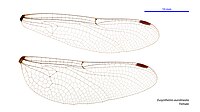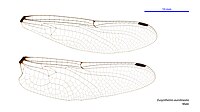Eusynthemis aurolineata
Appearance
| Variable tigertail | |
|---|---|
| Scientific classification | |
| Domain: | Eukaryota |
| Kingdom: | Animalia |
| Phylum: | Arthropoda |
| Class: | Insecta |
| Order: | Odonata |
| Infraorder: | Anisoptera |
| Family: | Synthemistidae |
| Genus: | Eusynthemis |
| Species: | E. aurolineata
|
| Binomial name | |
| Eusynthemis aurolineata (Tillyard, 1913)[2]
| |

| |
Eusynthemis aurolineata is a species of dragonfly of the family Synthemistidae,[3][4] known as the variable tigertail.[5] It is a medium-sized dragonfly with black and yellow markings.[5] It inhabits mountain swamps and streams in eastern Australia[6][7]
Eusynthemis aurolineata appears similar to Eusynthemis guttata which is found in alpine streams.[5]
Gallery
-
Female wings
-
Male wings
See also
References
Wikimedia Commons has media related to Eusynthemis aurolineata.
- ^ Hawking, J. (2009). "Eusynthemis aurolineata". IUCN Red List of Threatened Species. 2009. IUCN: e.T163579A5618499. doi:10.2305/IUCN.UK.2009-2.RLTS.T163579A5618499.en.
- ^ Tillyard, R.J. (1913). "On some Australian Anisoptera, with descriptions of new species". Proceedings of the Linnean Society of New South Wales. 37 (1912): 572–584 [575]. doi:10.5962/bhl.part.22358 – via Biodiversity Heritage Library.
- ^ "Species Eusynthemis aurolineata (Tillyard, 1913)". Australian Faunal Directory. Australian Biological Resources Study. 2012. Retrieved 4 March 2017.
- ^ Schorr, Martin; Paulson, Dennis. "World Odonata List". Slater Museum of Natural History. University of Puget Sound. Retrieved 4 March 2017.
- ^ a b c Theischinger, Günther; Hawking, John (2006). The Complete Field Guide to Dragonflies of Australia. Collingwood, Victoria, Australia: CSIRO Publishing. p. 210. ISBN 978-0-64309-073-6.
- ^ Theischinger, Gunther; Endersby, Ian (2009). Identification Guide to the Australian Odonata (PDF). Department of Environment, Climate Change and Water NSW. p. 213. ISBN 978-1-74232-475-3.
- ^ Watson, J.A.L.; Theischinger, G.; Abbey, H.M. (1991). The Australian Dragonflies: A Guide to the Identification, Distributions and Habitats of Australian Odonata. Melbourne: CSIRO. p. 278. ISBN 0643051368.



